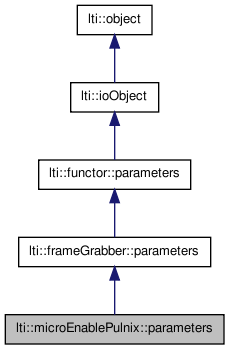

|
latest version v1.9 - last update 10 Apr 2010 |
|
frameGrabber parameters class More...
#include <ltiMicroEnablePulnix.h>


Public Types | |
| enum | eShutterMode { SMUninitialized = -1, DirectM, DirectA, Manual, Async } |
| enum | eEdgeEnhancement { EEUninitialized = -1, Off = 0x00, Horizontal = 0x04, Vertical = 0x08, Both = 0x0C } |
| enum | eWhiteBalanceType { WBUninitialized = -1, WBManual, WBAuto } |
Public Member Functions | |
| parameters () | |
| parameters (const parameters &other) | |
| ~parameters () | |
| parameters & | copy (const parameters &other) |
| virtual functor::parameters * | clone () const |
| virtual const char * | getTypeName () const |
| virtual bool | write (ioHandler &handler, const bool complete=true) const |
| virtual bool | read (ioHandler &handler, const bool complete=true) |
| virtual bool | download (const serial::parameters::ePortType &serialPort, const bool &allBanks=true) |
Public Attributes | |
| serial::parameters::ePortType | serialPort |
| bankType * | bank |
| int | currentBank |
| int | bufferSize |
| point | windowSize |
| point | windowOffset |
Protected Member Functions | |
| virtual bool | upload (const serial::parameters::ePortType &serialPort, const bool allBanks=false, const bool force=false) const |
Static Protected Attributes | |
| static point | camWindowSize |
| static point | camWindowOffset |
| static int | camCurrentBank |
frameGrabber parameters class
Possible shutter modes.
white balance mode
| lti::microEnablePulnix::parameters::parameters | ( | ) |
default constructor
Reimplemented from lti::frameGrabber::parameters.
| lti::microEnablePulnix::parameters::parameters | ( | const parameters & | other | ) |
copy constructor
Reimplemented from lti::frameGrabber::parameters.
| lti::microEnablePulnix::parameters::~parameters | ( | ) | [virtual] |
destructor
Reimplemented from lti::functor::parameters.
| virtual functor::parameters* lti::microEnablePulnix::parameters::clone | ( | ) | const [virtual] |
returns a pointer to a clone of the parameters.
Reimplemented from lti::frameGrabber::parameters.
| parameters& lti::microEnablePulnix::parameters::copy | ( | const parameters & | other | ) |
copy member
Reimplemented from lti::frameGrabber::parameters.
| virtual bool lti::microEnablePulnix::parameters::download | ( | const serial::parameters::ePortType & | serialPort, | |
| const bool & | allBanks = true | |||
| ) | [virtual] |
read the parameters from the camera, assuming that the serial port of the pulnix camera is connected at the given serial port.
This will take a while! You can choose if you want to read all parameter sets or the current bank only.
To send the parameters to the camera use the method setParameters() of the microEnablePulnix functor.
| serialPort | the serial port used to communicate with the camera. (Com1, Com2, ...) | |
| allBanks | if true, all parameter banks will be read. Otherwise only the current bank will be read. |
| virtual const char* lti::microEnablePulnix::parameters::getTypeName | ( | ) | const [virtual] |
returns the type name
Reimplemented from lti::frameGrabber::parameters.
| virtual bool lti::microEnablePulnix::parameters::read | ( | ioHandler & | handler, | |
| const bool | complete = true | |||
| ) | [virtual] |
read the parameters from the given ioHandler
| handler | the ioHandler to be used | |
| complete | if true (the default) the enclosing begin/end will be also written, otherwise only the data block will be written. |
Reimplemented from lti::frameGrabber::parameters.
| virtual bool lti::microEnablePulnix::parameters::upload | ( | const serial::parameters::ePortType & | serialPort, | |
| const bool | allBanks = false, |
|||
| const bool | force = false | |||
| ) | const [protected, virtual] |
send the parameters to the camera, assuming that the serial port of the pulnix camera is connected to the given serial port.
This will upload only those parameter that have changed! You can choose if you want to send only the current bank (default) or if you want to send all parameters banks.
| serialPort | the serial port used to communicate with the camera. (Com1, Com2, ...) | |
| allBanks | if true, all parameters sets will be send to the camera. If false, only the current bank will be send. | |
| force | if true, everything will be senden, ignoring the content of the "camera shadow" |
| virtual bool lti::microEnablePulnix::parameters::write | ( | ioHandler & | handler, | |
| const bool | complete = true | |||
| ) | const [virtual] |
read the parameters from the given ioHandler
| handler | the ioHandler to be used | |
| complete | if true (the default) the enclosing begin/end will be also written, otherwise only the data block will be written. |
Reimplemented from lti::frameGrabber::parameters.
The four parameter banks.
Amount of memory in bytes to be allocated on the host to communicate with the grabber (Default 8MB=8*1024*1024).
This parameter is consider just once, at the initialization. After that, it is not possible to change the buffer size.
int lti::microEnablePulnix::parameters::camCurrentBank [static, protected] |
current bank in the camera
point lti::microEnablePulnix::parameters::camWindowOffset [static, protected] |
offset of the grabbed window
These are the real values in the camera/frame grabber, used to detect if the table needs to be resend.
point lti::microEnablePulnix::parameters::camWindowSize [static, protected] |
dimensions of the grabbed window
These are the real values in the camera/frame grabber, used to detect if the table needs to be resend.
The parameter-bank number to be used.
This must be a value between 0 and 3. Only the last two bits of the given value will be considered. Default value: 3
offset of the grabbed window (default 104x40)
dimensions of the grabbed window (default 640x480)